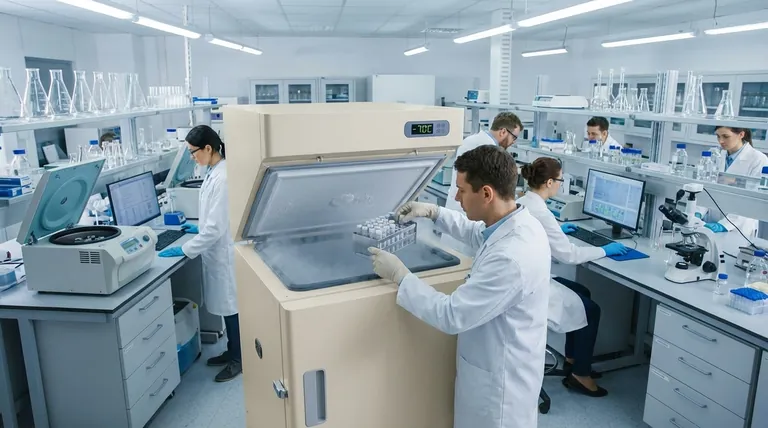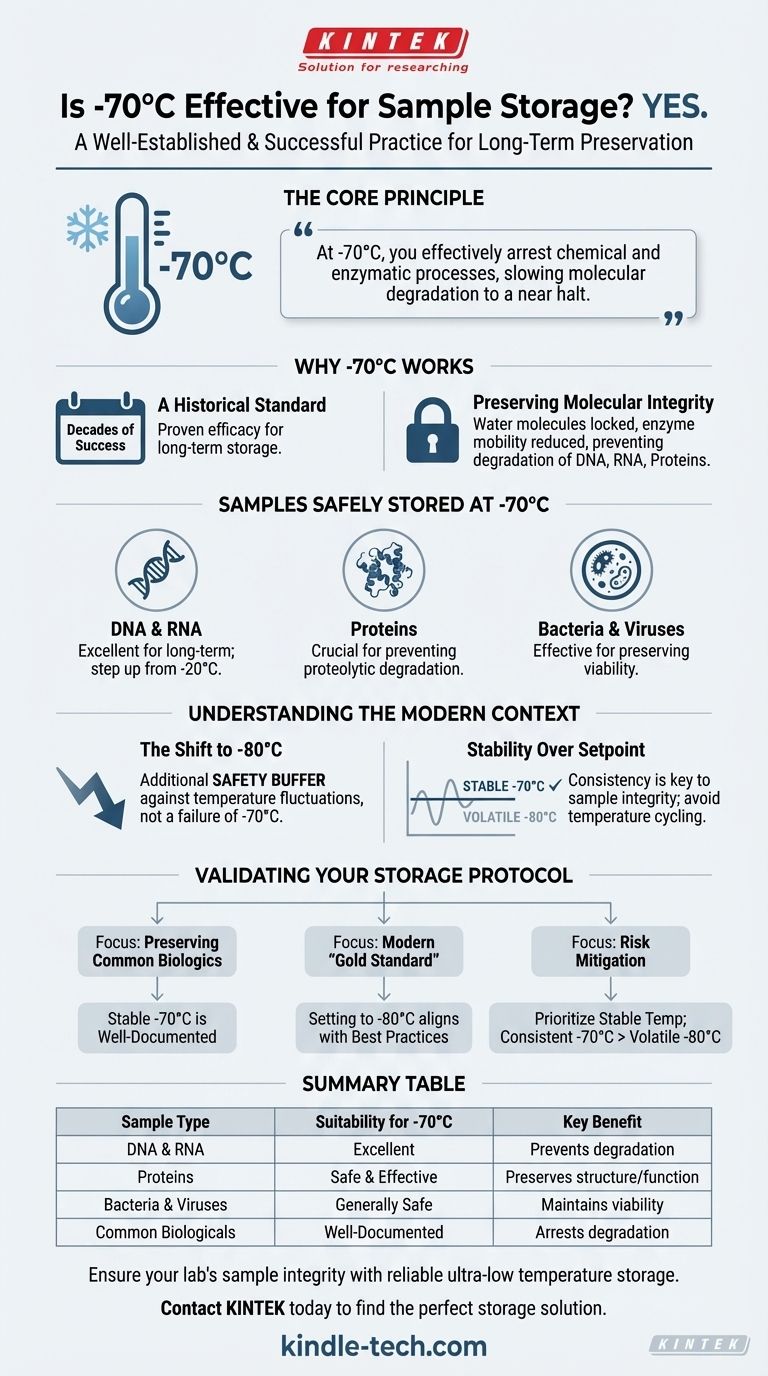Yes, absolutely. Storing samples at -70°C is a well-established and successful practice confirmed by many laboratories. This temperature has historically been a standard for ultra-low temperature (ULT) freezers and is proven effective for the long-term preservation of a wide range of common biological materials.
The core principle is that -70°C is well below the freezing point of water and slows molecular degradation to a near halt. While modern freezers often target -80°C, a stable -70°C environment is a valid and historically proven method for maintaining the integrity of many critical samples.

Why -70°C is an Effective Storage Temperature
The primary goal of ultra-low temperature storage is to stop time, biologically speaking. At -70°C, you effectively arrest the chemical and enzymatic processes that degrade samples at warmer temperatures.
A Historical Standard
For many years, the operational target for ULT freezers was -65°C or -70°C. Decades of research and sample preservation were successfully conducted using this standard, proving its efficacy for long-term storage.
Preserving Molecular Integrity
At these deep-freeze temperatures, water molecules are locked in place, and the mobility of enzymes and reactive chemicals is drastically reduced. This prevents the degradation of sensitive molecules like DNA, RNA, and proteins over extended periods.
What Samples are Safely Stored at -70°C?
A stable -70°C environment is suitable for a broad array of common biological samples used in research and diagnostics.
Nucleic Acids (DNA & RNA)
Both DNA and RNA can be safely stored at -70°C for long-term preservation. This is a significant step up from -20°C, which is typically suitable for shorter durations.
Proteins
Most proteins and protein extracts are safely stored at -70°C. This temperature is crucial for preventing proteolytic degradation and maintaining the protein's native structure and function.
Bacteria and Viruses
Microorganisms, including bacterial stocks and viral isolates, are generally safe at -70°C. This temperature effectively preserves their viability for future culturing or analysis.
Understanding the Modern Context
While -70°C is proven effective, it's important to understand why -80°C has become the more common standard in modern laboratories.
The Shift to -80°C
The move to -80°C was not driven by a failure of the -70°C standard. Rather, it provides an additional safety buffer. This extra 10-degree margin helps protect samples against temperature fluctuations that occur during brief door openings and provides an even greater reduction in any residual enzymatic activity.
Stability Over Setpoint
The single most damaging factor in long-term storage is temperature cycling—the process of warming and re-cooling. A freezer that maintains a rock-solid -70°C is far superior to one that fluctuates between -80°C and -65°C. Consistency is the key to sample integrity.
Validating Your Storage Protocol
Use this framework to determine if -70°C is the right choice for your laboratory's needs.
- If your primary focus is preserving common biologics: A stable -70°C is a well-documented and effective temperature for nucleic acids, proteins, and microbes.
- If your primary focus is adhering to the modern "gold standard": Setting your ULT freezer to -80°C aligns with current best practices and provides an enhanced safety margin.
- If your primary focus is risk mitigation: Prioritize maintaining a stable temperature above all else; a consistent -70°C is superior to a volatile -80°C.
Ultimately, a stable and well-monitored ultra-low temperature environment is the cornerstone of reliable sample preservation.
Summary Table:
| Sample Type | Suitability for -70°C Storage | Key Benefit |
|---|---|---|
| DNA & RNA | Excellent for long-term | Prevents degradation, maintains integrity |
| Proteins | Safe and effective | Preserves structure and function |
| Bacteria & Viruses | Generally safe | Maintains viability for future use |
| Common Biologicals | Well-documented efficacy | Arrests chemical and enzymatic degradation |
Ensure your lab's sample integrity with reliable ultra-low temperature storage. At KINTEK, we specialize in providing high-performance lab equipment, including ultra-low temperature freezers designed for stable, consistent preservation of your most valuable biological samples. Whether you're storing at -70°C or -80°C, our solutions help you maintain sample viability and comply with modern best practices. Contact us today to find the perfect storage solution for your laboratory's needs.
Visual Guide

Related Products
- 608L Essential Laboratory Ultra Low Temperature Freezer For Critical Sample Preservation
- 408L Advanced Vertical Laboratory Ultra Low Temperature Freezer for Critical Research Material Preservation
- 108L Vertical Ultra Low Temperature ULT Freezer
- 28L Compact Upright Ultra Low Temperature Freezer for Laboratory
- 508L Advanced Vertical Ultra Low Temperature Freezer for Critical Laboratory Storage
People Also Ask
- What makes Ultra-Low Temperature freezers energy efficient? Key Design & Operational Strategies
- In what fields are ultra low temperature freezers most commonly used? Essential for Biomedical, Clinical, and Research Labs
- How do Ultra-Low Temperature freezers ensure the integrity of microbiological samples? Maintain Stability for Critical Research
- What factors should be considered when selecting an ultra-low temperature freezer? Ensure Sample Integrity and Long-Term Value
- What are the common designs of ultra-low temperature freezers? Upright vs. Chest Models for Your Lab



















